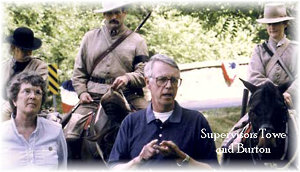Hibbs Bridge Dedication
Remarks, Hibbs Bridge dedication, 16 November 2007
J. Marvin Watts
It’s cheering to see so many friends of Hibbs Bridge here.
This day has been nearly 18 years in the coming. I promise I won’t take so long. I think to alleviate anxiety because I’ve just been reading Izaccson’s quite wonderful Einstein. At a reception amidst interminable speeches, Einstein turned to his seatmate, a Dutch diplomat, to remark: “I’ve just developed a new theory of eternity.”
Some of us used to think eternity was the timeline for restoring Hibbs.
The modern saga of Hibbs Bridge began when then county administrator Phil Bolen received a letter from VDOT dated 8 May 1990. It inquired mildly whether anyone would be distressed if Hibbs Bridge were dynamited and replaced with a 450 foot concrete slab.
Well … VDOT didn’t put it exactly that way.
Loudoun citizens were almost universally opposed to tampering with the bridge other than to restore it and keep it in use.
And yet how difficult it is to get folks to do the “right” thing, isn’t it? To stay married everlastingly to the same person, for example, or to save another artifact of history such as a stone bridge.
I’d like to first emphasize the importance of our accomplishment, putting Hibbs in its historical and cultural context. Then I’d like to celebrate some of those who acted to make possible the results we see today.
Hibbs was originally built for economic reasons.
Hibbs was saved chiefly by the love for it by ordinary citizens.
They loved it not just for its simplicity and natural beauty, but also for its eccentric hump, democratically available to anyone with a vehicle.
Hibbs has been a part of the fabric of Loudoun lives for 185 years. So in saving Hibbs, we prevent that tear in community fabric suffered whenever an historical or natural feature of our mutual experience is razed. We thus husband and protect our own humanity in the interests of posterity.
That’s a triumph for all Loudoun citizens, for all Virginians, including the Virginia Department of Transportation.
Let us see why Hibbs deserved adulation, for it is not just any old bridge.
Having conveyed travelers over Beaverdam Creek on Old Snickers’ Gap Turnpike south of Philomont since about 1822, it is Loudoun’s third oldest. The others are the 1806 Rt. 50 bridge over Little River at Aldie, and the 1820 Ashby’s Gap Turnpike bridge which crosses Goose Creek on the abandoned alignment west of Middleburg. There are only a few other barrel vault bridges in Virginia. Hibbs construction was a direct result of the burgeoning of American energy and genius in bridge building. The poet Moore described early Virginia bridges as, “Made of a few uneasy planks / In open ranks / Over rivers of mud.”
Throughout the 17th and 18th centuries, insecure, miserable, floating makeshifts were common across wide rivers. Yet by the end of the 18th century Americans excelled in the art.
Lemuel Cox, a Medford shipwright, in 1786 built a bridge of oak and pine across the Charles River from Boston to Charlestown, at the time the longest bridge in the world. He had earlier practiced with a 900 foot bridge over the Foyle in Ireland, a feat the great English engineer Milne said was impossible.
Thereafter, according to Virginia historian Alice Morse Earle, “Throughout Maryland, Pennsylvania and upper Virginia, fine wooden and stone bridges were built. On all the turnpikes, the bridges equaled the roads,” he said.
The barrel vault style of Hibbs Bridge originated early in the East (Homer remarks on it, for example), there the Romans learned about arch construction and quickly improved on the art.
The most ancient bridges that survive into the present are Roman. By the second century B.C., they had built bridges whose beauty and excellence have not been surpassed.
For example, following 18th century war damage to a Roman bridge in Spain, Isabella the Catholic had the masonry meticulously restored, yet in less than 300 years the new work had to be redone while the original Roman work was still good.
One of the oldest is the Pons Senatorius, constructed about 181 B.C. and still almost completely intact in 1575, when Gregory XIII restored it. In modern France, Roman bridges spanning several rivers remain in regular use.
So you can see, restoration is a venerable practice.
It was a mark of advanced civilizations that beauty be important in the construction, so the earliest engineers built structures so they appeared correct to the eye. The results were more pleasing in appearance, as with Hibbs, than today’s coldly scientific steel and concrete slabs, which have the additional flaw of collapsing unexpectedly. They are designed for only 75 or 100 years of service, and a recent New York Times article described such bridges as “big, dumb pieces of steel and concrete, and mostly out of mind, until one collapses….”. Such as the I35W bridge in Minneapolis.
Stone arch bridges do not readily collapse. Even Aristotle speaks of arch keystones, such as those which supported Hibbs, by the “resistance which they oppose to all parts.”
The Romans also designed bridges to be in perfect harmony with their surroundings. The celebrated 16th century Italian architect Palladio summed up these principles: “Bridges … ought to be convenient, beautiful, and durable.”
Unfortunately, modern engineers, given modern materials and technology, could ignore ancient bridge technology and art. Thus began the decline of beauty.
Likewise, modern engineers are not employed to pay attention to either natural setting or product appearance. The terrain is dynamited and bulldozed. Only safety (a little ironically) and cost are benchmarks. Still, amortized over two millennia, a Roman bridge is pretty inexpensive.
Hibbs meets one authority’s Roman expectations for old stone bridges, for it has the “greatest charm” owing to the “local landscape which has aged and mellowed, blending the bridge with the landscape.”
As all here appreciate, on the east Hibbs is anchored in a massive stone outcrop where a small waterfall splashes into a deep clear pool (at least in between droughts). An immediate profusion of sycamores, oaks, hickories, black walnuts, and river birch soften the steep hillsides on either side.
I concede, as some complain, the rehabilitated Hibbs looks a little new. Indeed, it is missing moss and lichen and the occasional fern adorning a masonry crack. But time will take care of that.
It has been restored to its original dimensions and, thanks to project manager Ron Mallory, within budget at under 1.8 million, many times less than a “modern” bridge would have cost. Where a bridge has merit, this approach has become attractive to VDOT not just for the savings: it avoids right-of-way acquisition, engineering studies, public hearings, and may save time as well – at least in construction. I urge VDOT to continue this classical approach and take credit for it. It is excellent public relations.

 Formally, Tommy Dodson, a four-term Loudoun County supervisor from Middleburg, was the first. Phil Bolen gave Tommy the 1990 VDOT letter, Hibbs being in his district, then Mercer. Tommy took many initiatives culminating in his submitting to the board of supervisors in 1992 a resolution establishing the ground rules for maintaining the integrity of the historic structure and its natural setting. It passed 9-0, and the county since has never wavered.
Formally, Tommy Dodson, a four-term Loudoun County supervisor from Middleburg, was the first. Phil Bolen gave Tommy the 1990 VDOT letter, Hibbs being in his district, then Mercer. Tommy took many initiatives culminating in his submitting to the board of supervisors in 1992 a resolution establishing the ground rules for maintaining the integrity of the historic structure and its natural setting. It passed 9-0, and the county since has never wavered.